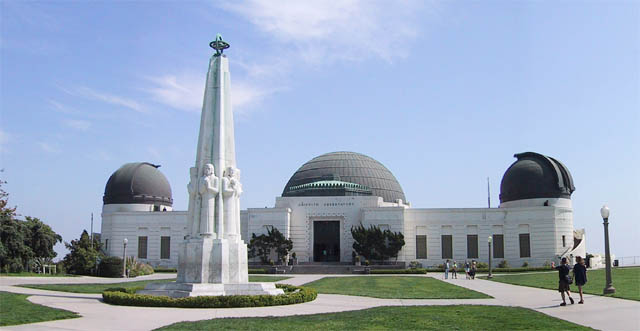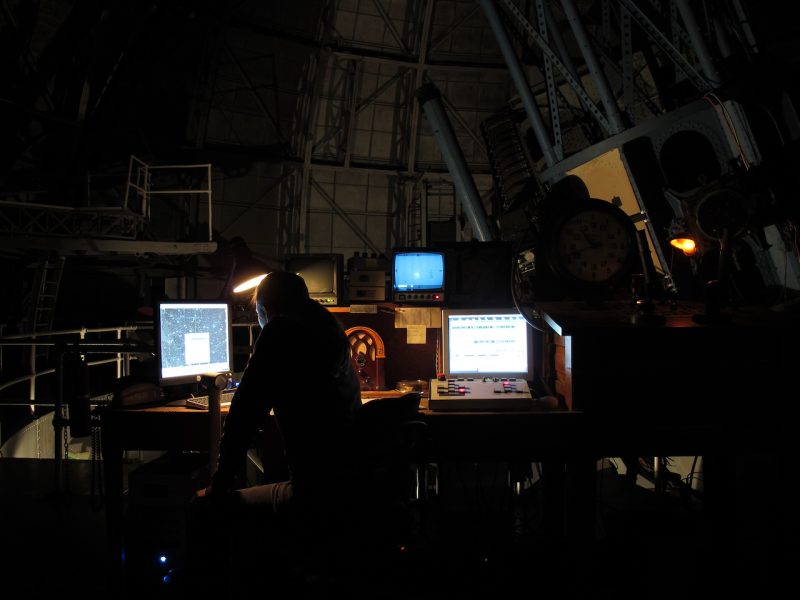Carla Johns is a medium but not that kind of medium. She does not channel ghosts of the dead. Her spiritual wellspring is photons, traveling from stars throughout the universe at unimaginable speed to fill the telescopes Johns fondly refers to as light buckets. Observatories are her cathedrals.

Gary Seronik
At Griffith Observatory in Los Angeles, photons spoke to Johns through telescopes, and Johns spoke to hundreds of people every night as she fielded questions about black holes, quasars, binary stars. Hugs came from children and old men alike. There was an engineer from the Russian space program. Buddhist monks from Thailand. Lucy Lawless, star of Xena: Warrior Princess, nearly knocked over one of the smaller telescopes out of sheer excitement.
Griffith itself is beautiful, out on prominent bedrock overlooking the city, the iconic Hollywood sign next door. Director Ed Krupp calls Griffith “the hood ornament of Los Angeles.” One of its telescopes, a 12-inch Zeiss refractor, has had more people peer into it — 7 million and counting — than into any other light bucket in the world.
Johns moved to Los Angeles to be with her future husband and was supposed to be looking for work in human resources. But the webcam on the Astronomers Monument kept distracting her. The feed showed Griffith, closed for renovations. Johns checked the feed for signs of construction progress first thing every morning. One day she saw a job posting at the bottom, tucked under the feed: Griffith was looking for museum guides. Within a week after having arrived in Los Angeles, Johns applied for the job and was accepted.
At orientation, Johns introduced herself to the crowded room as Carla “20-inch Alvan Clark” Johns, which she says pricked the ears of the “old crusty white dudes.” (Johns describes these dudes in terms of endearment; she credits them for welcoming more women and people of color into the club of astronomy in recent years.) Did she say 20-inch Alvan Clark? Then a familiar question from her past: Did she want to learn how to operate the telescope at Griffith, rather than be a museum guide?
“Hell yeah,” Johns said.
Griffith was one of the most rewarding experiences of her life. She can still hear the tick of the clock. The hum of the motor. The sound of the roof as it rotates. As a telescope operator, Johns decided where to point the Zeiss and physically moved it into place before locking it down. Then its motor took over to keep the telescope on track. On any given night, Johns might show a little kid a piece of the solar system through the telescope for the first time, then an 85-year-old for his first and perhaps last time.
“Did we just look at the Sun?” a young woman asked Johns one night. The woman was a newcomer to Griffith and obviously torn. Was it wise to indulge her own curiosity and come off as a nerd? Or ask stupid questions and appear ignorant? What would her date think? Curiosity ultimately got the best of her. It was not the Sun they saw through the telescope, but Saturn, and no, Saturn is not a star. “Wait,” the woman said. “Start all over. Tell me all about the solar system.”

Jim Mahon
It wasn’t Saturn that moved Johns, like the woman at Griffith, but Jupiter, seen through a small Celestron telescope. She first saw the giant planet during her first astronomy class at the Denver Museum of Nature and Science, a half-hour drive from her hometown of Brighton, Colorado. She was in her late twenties and worked in human resources for county government. Inspired by the comets Hale–Bopp and Hyakutake in the 1990s, Johns took the class on a whim.
“I stood there and started bawling like a baby,” Johns says. “It was Jupiter and the four Galilean moons. I knew my life had to change.”
Jupiter is her favorite object in the solar system. Except for the Sun it’s also the largest, a maelstrom of hydrogen and helium. It now boasts 79 moons at latest count, but even a modest backyard telescope — or Galileo Galilei’s handmade telescope 400 years ago — can make out the four points of light that are Io, Europa, Ganymede, and Callisto. “Not everything orbits the Earth,” Johns says. “We have to think that we’re the center of everything. Jupiter taught us, nuh-uh, we’re nothing.”
Galileo saw that the bright objects around Jupiter were not fixed stars, but moons, and that these moons were in orbit around Jupiter, much like our own moon around Earth. This is what Johns saw through the Celestron. The universe, it turns out, does not revolve around humanity, and our light buckets let us see this reality. We enter observatories feeling big, Johns explains, with the residual halo of our daily lives and concerns still on us. Then we peer into the light bucket and are made to feel small.
Jupiter could swallow 1,300 Earths.
After Johns saw Jupiter through a telescope, her life did change. Two introductory astronomy courses at the museum led to a third course in binocular astronomy, and to the late Larry Brooks, president of the Denver Astronomical Society. Then one evening, the society was having an open house.
Brooks took Johns to see the 20-inch Alvan Clark-Saegmuller telescope at Chamberlin Observatory at the University of Denver. It’s something from the Victorian age, Johns tells me, outlining its ornate features with raised arms and hand gestures. The mount is cast iron, and to move the telescope, operators lay hands on it rather than use a computer, much like the Zeiss at Griffith.
“It’s an exquisite telescope,” Johns says. “I knew it had a soul.”
Johns was so smitten with the telescope that she ignored the sky itself. Brooks noticed. Did she want to learn how to use it? At the time, Johns did not own a single telescope (though she now has three or four refractors and an 8-inch Dobsonian that she uses to “get more photons”). It was a traditional apprenticeship. She swept the floors. She dusted for open houses. It took six months and a driver’s test at the end. By the time Johns left Colorado for 10 years in Los Angeles, she could operate the 20-inch at Chamberlin, and pinpoint Jupiter in the sky.
Old observatories smell like kerosene.
Johns closes her eyes and inhales deeply with a blissful smile. “Once you get to know the telescopes,” Johns says, “you know how they should smell, you know the smell of that grease.” She’s thinking about the big telescopes at Mount Wilson Observatory, also in Los Angeles, where the telescopes are centenarians. The 60-inch telescope went operational in 1908. The 100-inch Hooker telescope — named after philanthropist John Hooker and the most intimidating telescope Johns has used — started operating in 1917. It’s so big that motors and encoders and a computer drive it; there is no physical push and pull. The movable parts alone weigh 87 tons. To peer into the Hooker takes a three-story climb just to get to the telescope floor.
In observational astronomy, Johns explains, aperture is king. The bigger the aperture (the diameter of the lens in refracting telescopes or the mirror in reflecting telescopes), the more light the telescope collects. The bigger the light bucket, the more we see.
The best view Johns ever had of Earth’s moon was through the 60-inch at Mount Wilson: “I felt like I was Mike Collins in a capsule going around it.” As Neil Armstrong and Buzz Aldrin made boot prints on the Moon’s surface in 1969, Collins orbited in the command module 115 miles above them, a figurative stone’s throw. What we see from Earth with the naked eye is 238,900 miles away. “You can literally see light coming out of the eyepiece,” Johns says of the 60-inch, “a shaft of light it’s so bright.”

Jim Mahon
Since her time in Los Angeles, Johns has moved back home to Colorado, where she works at the University of Colorado’s Fiske Planetarium. Johns also curates websites for Professor Jack Burns, who is researching the feasibility of Moon-based observatories. His obsession, Johns says, is the cosmic dawn — and the best way to study the cosmic dawn is to put a telescope on the Moon’s farside, where it’s radio quiet. And Johns is now an official astronomy instructor at the community college she attended while still in high school. It has come full circle, she tells me.
I ask her about school on Monday. She’s prepping a lecture and quiz about the history of astronomy and the people who contributed to the field. She rattles off the names: Brahe, Copernicus, Kepler — people who, like Johns, fell in love with the sky and passed their knowledge down.
 6
6
Comments
Jim Mahon
June 22, 2021 at 4:20 pm
As one of the crusty Griffith white guys, it's great to see my best observing buddy being celebrated...
You must be logged in to post a comment.
Laura Danly
June 25, 2021 at 4:30 pm
Carla! What a wonderful article. As Carla's former boss I can attest to how wonderful it is to work with her, what a wonderful communicator she is, and what service she has provided to her community. We missed her when she left.
(And hello, Crusty Jim Mahon, miss you too.)
You must be logged in to post a comment.
AB
June 26, 2021 at 8:55 pm
A really cool story 😀 I enjoy reading about people who are so passionate about their work/interests.
You must be logged in to post a comment.
7h7dqsd1vz54
June 26, 2021 at 11:10 pm
What a nice story. Thanks.
You must be logged in to post a comment.
mduva21
June 27, 2021 at 7:15 am
What a terrific story! I feel inspired about astronomy again! Thank you!
You must be logged in to post a comment.
Bob King
June 27, 2021 at 5:00 pm
Chris,
This is a wonderful story! Beautifully written. She is an inspiration.
You must be logged in to post a comment.
You must be logged in to post a comment.